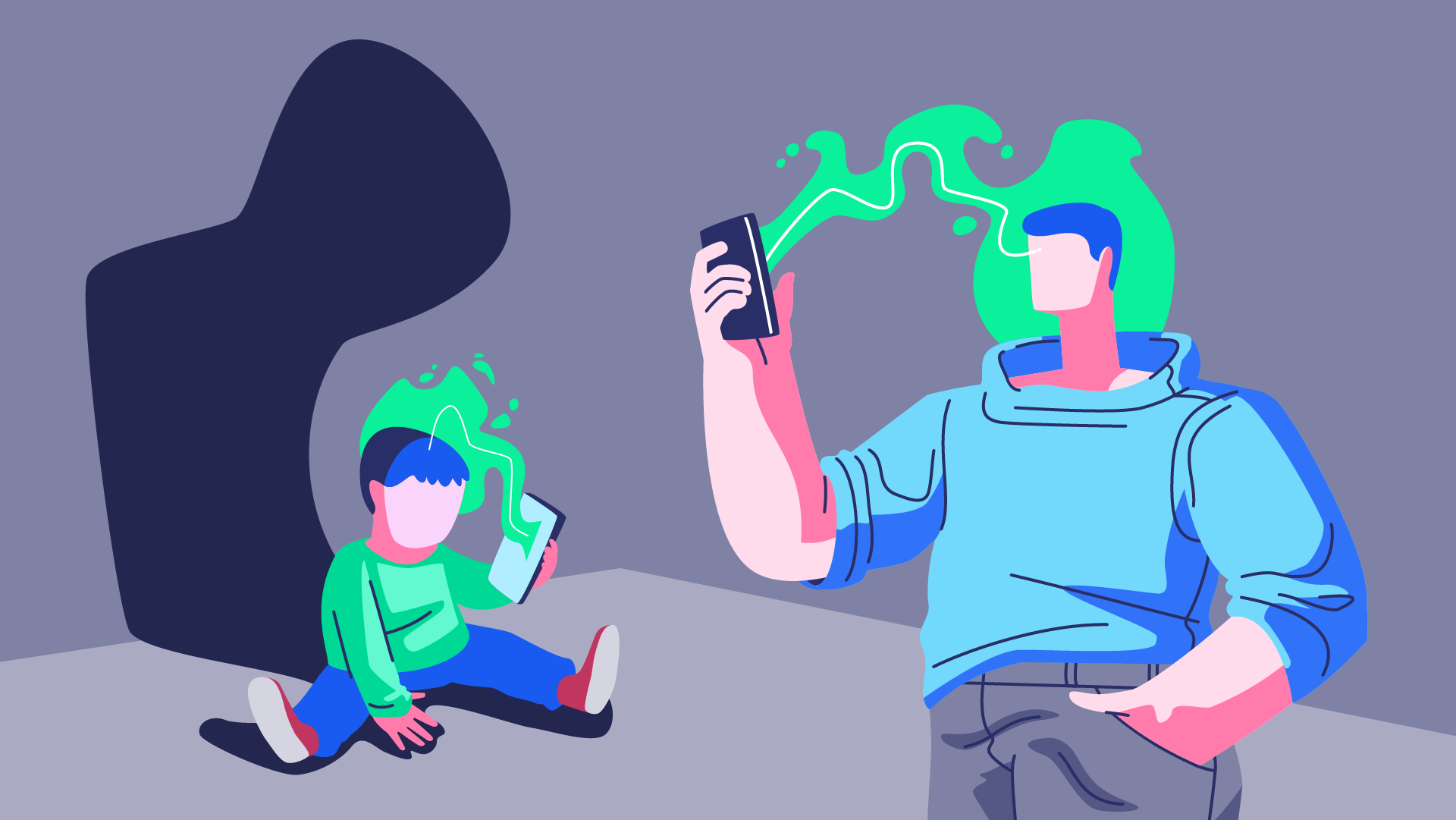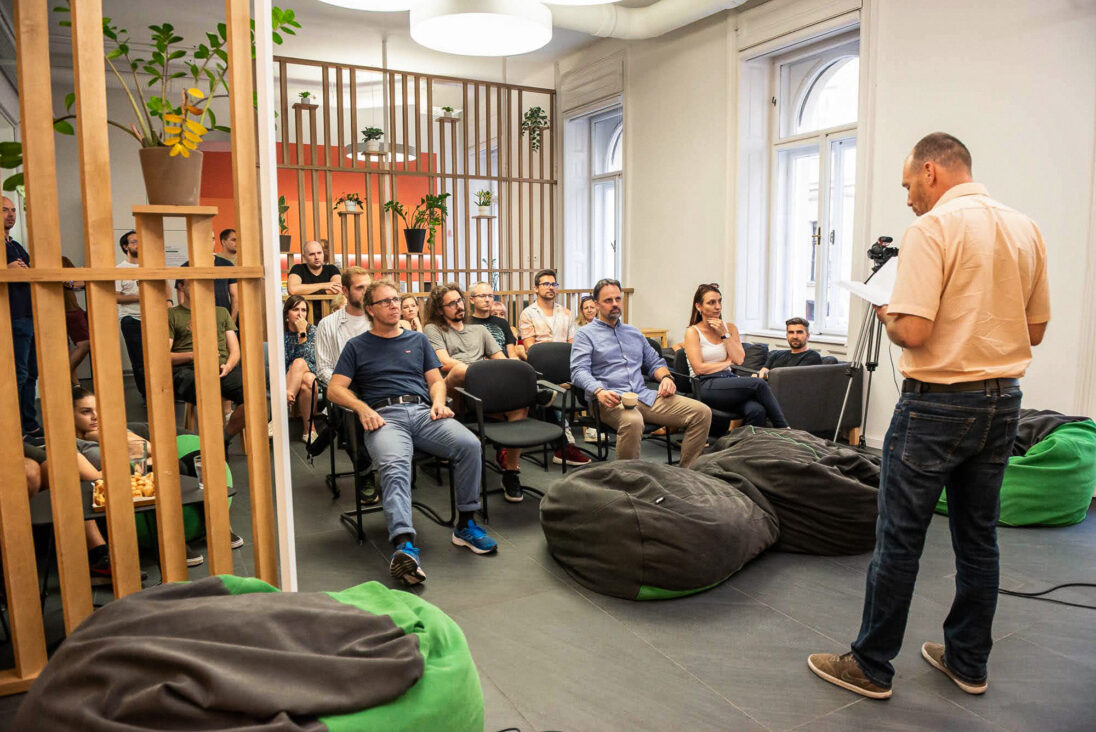
Mi ellen harcolunk valójában?
Nem a technológia ellen – hiszen most is azt használom, hogy ezt a cikket megírjam, és te is azon keresztül olvasod.
A technológia önmagában nem ellenség. De amint elkezd helyettünk dönteni, rólunk szólni – sőt, használni minket –, akkor ideje elgondolkodni. Akkor már nem „segédeszköz”, hanem a figyelmünk fő elvonója. És a kapcsolataink rovására megy.
Az igazi kihívás nem más, mint visszavenni az irányítást önmagunk felett:
- Megismerni, hogy mi az, ami elviszi a figyelmünket.
- Őszintén beszélni erről egymással.
- És újra jelen lenni – a gyerekeinkkel, a társunkkal, magunkkal.
Könyv, csend, lelassulás – és a valóság súlya
A beszélgetés elején Kapitány-Fövény Máté Ezerarcú függőség című könyvéből olvastam fel egy részletet – offline, kézben tartott könyvből. Egy lassú, befelé figyelő kezdés volt ez, ami már önmagában kontrasztban állt a megszokott ritmusunkkal.
Aztán jöttek a példák, amik már nem voltak ilyen csendesek:
Nálunk minden reggel ordítás, ha el kell tenni a tabletet.”
“Van, hogy a gyerek rám szól: ‘anyu, te is csak nyomkodod a telefonod’.”
„A fiam Fortnite-ban győztes, de a matekdolgozatnál nem áll szóba velünk.
Ezek nem statisztikák – ezek hétköznapi mondatok. Közös valóság.
„Gamer pelus”, neuroplaszticitás, Baby Shark – és mi magunk
A beszélgetés során olyan fogalmak is előkerültek, mint a neuroplaszticitás (az agy újrakábelezhetősége), a digitális bódulat, vagy épp a „gamer pelus” – a szülői döbbenet egyik szimbóluma.
Beszéltünk arról is, hogy nemcsak a gyerekeket érinti a függés: sokunknak nehéz nem ránézni a telefonra, ha csak öt másodpercnyi szünetünk van.
De nem a bűntudatra kell építeni a változást. A bűntudat ugyanis blokkol. A lassulás, tudatos jelenlét, és az őszinte kapcsolódás viszont erőt ad.
És hogyan tovább? – Pár konkrét tipp, ami elhangzott
- Szemkontaktus reggelente
Ne a telefon legyen az első, hanem a másik ember. - Offline zóna otthon
Egy közösen kijelölt tér, ahová nem visszük a kütyüket. - Telefonmentes sávok
Pl. étkezésnél, lefekvés előtt. - Közös digitális napló
Együtt vezetett kis füzet, ahol a családtagok rögzíthetik, hogyan érzik magukat „kütyüzés” közben és után. - Tükörtartás egymásnak
Megbeszélni, ha úgy érezzük, a másik túlságosan eltűnik a képernyő mögött.

Egy cég, ami komolyan veszi a jövőt
Éppen ezért tartottunk egy meetupot a Virgoban, ahol a technológiai függőségről beszéltem az érdeklődő néhány tucat kollégámnak. Elmélyült közös folyamatban vettünk részt, és ezt azóta sok személyes visszajelzés is alátámasztja.
Nem feltételes módban beszéltem, és nem könnyed előadást tartottam. Persze, voltak vicces kiszólások, nevetések, de a sajátélményeink, a gyermekeink sorsa és az aggodalmas jövőkép borús hangulatot teremtett.
Hogyan is versenyezhetnénk például a Fortnite teremtette illúzióvilággal, aminek a közepén gyermekünk olyan élményeket él át nap mint nap, amelyhez foghatót a realitásban aligha fog megtapasztalni. Erről egy szépirodalmi igényű féloldalas írást olvastam fel az előadás elején, amely Kapitány-Fövény Máté Ezerarcú függőség című kötetéből származott. Elő, offline felolvasás egy valódi könyvből – jó volt így belassulni és megérkezni.
Dohányzás, alkoholizmus, kokain, kütyüfüggés, gamer pelus, Baby Shark Dance és Despacito, cro-magnoni hardver, neuroplaszticitás, és Nemzeti Dohánybolt – többek közt ezeket érintettük.
Nincsen csodafegyver, lassulni és tudatosodni kell, a bűntudat pedig akadályoz.
Önmagában példaértékű, hogy egy, a technológia használatában és fejlesztésében élenjáró cég beenged ilyen témát a falai és a munkatársai közé.

What Are We Really Fighting Against?
Not against technology – I’m using it right now to write this article, and you’re using it to read it.
Technology itself is not the enemy. But the moment it starts making decisions for us, speaking about us – or even using us – it’s time to reflect. At that point, it’s no longer just a tool; it becomes the main distraction from our attention. And it begins to take a toll on our relationships.
The real challenge is to reclaim control over ourselves:
- To understand what steals our attention.
- To talk honestly about it with one another.
- And to become present again – with our children, our partners, and ourselves.
Books, Silence, Slowing Down – and the Weight of Reality
To start the conversation, I read an excerpt from Máté Kapitány-Fövény’s book Addiction with a Thousand Faces – offline, from a physical book. It was a slow, inward-turning introduction, already in stark contrast with our usual pace.
Then came the real-life examples, which were not so quiet:
Every morning there’s yelling when it’s time to put away the tablet.”
“Sometimes my kid says: ‘Mom, you’re always on your phone too.’”
“My son is a Fortnite champion, but won’t even talk to us when it’s time for his math homework.
These are not statistics – they’re everyday sentences. A shared reality.
“Gamer Diaper,” Neuroplasticity, Baby Shark – and Ourselves
Throughout the discussion, terms like neuroplasticity (the brain’s ability to rewire itself), digital trance, and “gamer diaper” came up – the latter becoming a symbol of parental shock.
We also talked about how this dependency affects not just children. Many of us find it hard not to check our phones when we have just five seconds of downtime.
But change shouldn’t be driven by guilt – guilt paralyzes. Slowing down, being present, and connecting honestly, on the other hand, gives us strength.
What Can We Do? – A Few Practical Tips Shared
- Eye contact in the mornings
Let a human face, not a screen, be the first thing you see. - Offline zone at home
A shared, designated space where no devices are allowed. - Phone-free zones
For example, during meals or before bedtime. - Family digital journal
A small notebook where everyone can jot down how they feel during or after screen time. - Holding up a mirror
Talk to each other when someone seems too absorbed in the screen.

A Company That Takes the Future Seriously
That’s why we organized a meetup at Virgo, where I spoke to a few dozen colleagues about tech addiction. It turned into a deep, shared process, confirmed by many personal reflections since.
I didn’t speak hypothetically, nor did I give a light-hearted presentation. Sure, there were some laughs and humorous comments, but our own experiences, our children’s futures, and our shared anxieties painted a rather somber picture.
How could we possibly compete with the world of illusions created by Fortnite, where our kids experience daily highs that reality can hardly replicate?
I read a short, literary excerpt at the beginning of the talk about this very dilemma – again, from Kapitány-Fövény Máté’s Addiction with a Thousand Faces. Reading it live, from a real book – it helped us slow down and arrive in the moment.
Smoking, alcoholism, cocaine, screen addiction, gamer diapers, Baby Shark Dance and Despacito, Cro-Magnon hardware, neuroplasticity, and the National Tobacco Shop – these were just some of the things we touched on.
There’s no magic bullet. We need to slow down and become more mindful. And guilt only gets in the way.
It’s remarkable in itself that a company leading in the use and development of technology allows a topic like this to be brought within its walls and into the lives of its people.

“Good enough” feedback, whether given or received, can serve as a powerful resource in our lives—both at work and at home. To fully harness its potential, as usual, it takes self-awareness and mindfulness.
Today, it’s common practice in most workplaces to request and give formal feedback among colleagues, about each other and even about themselves.
In bureaucratic organizations, feedback tends to come only from leaders about their subordinates, in written form, typically bi-annually or annually. The subordinate receives their evaluation in writing, where it’s made clear how this will affect their potential bonus or future salary. In these hierarchical organizations, these feedback loops aren’t given real weight; they’re just another operational rule that’s trendy nowadays, so they “have to be done.”
The next level of organizations, typically multinational corporations, remains quite hierarchical but assigns importance to individuals in the name of efficiency. Feedback is gathered from multiple sources, and even colleagues can evaluate their superiors (e.g., 360-degree evaluations). However, the focus of the feedback typically remains on roles—a mask speaks to a mask, since “we’re professionals” and we focus on the numbers.
Typical feedback: “They micromanage too much” or “Their communication isn’t effective.” While these comments are likely true, they’re essentially meaningless because they describe symptoms, not the root causes.
To receive real, valuable feedback that we can actually use, we need to take off the masks and speak person-to-person. Additionally, we must understand that feedback inherently has three layers: the person being evaluated, the person giving the feedback, and the relationship between them.
Let’s take a few examples:
“I don’t like that they always ask follow-up questions.”
This is pretty good feedback, especially if I add, “because it makes me uncertain.” Now it includes the cautious person who needs to know everything, my own insecurity, and the dynamic between us, where we haven’t discussed this in real time, and so it ends up in the “official” anonymous feedback session.
“They’re not tough enough with clients.”
Here, the feedback giver clearly sees themselves as being tougher. Of course, no one can know for sure what impact that would have, or whether it would be better than the current approach—because, as Milan Kundera tells us, life is but a sketch.
From these examples, it’s clear to me that without self-awareness and mindfulness, even diligently gathered feedback will fall flat and take no root. And without that, what’s the point?
How does it work at Virgo? – Ági Józsa-Török, HR Lead
At every level of our organization, feedback is genuinely valued—this is not just corporate speak. Feedback is something we can all build upon. Managers rely on feedback from employees to identify directions for organizational change, and colleagues receive the information they need for personal and professional growth from each other and their leaders. Even in the first few months after joining, we have several conversations where both the new colleague and the company can share their thoughts about the onboarding process. These discussions provide opportunities to grow together during the onboarding period, fine-tune the job role, and align mutual expectations. After settling in, employees receive official feedback from each other at least once a year, which they review during career discussions with their direct supervisor and HR, using it to map out development paths for the coming period.
For organizational development, it’s crucial that our colleagues regularly share their opinions about the company’s operations, values, and direction. Feedback comes through satisfaction surveys, employee evaluations, strategic discussions, and value assessments, all of which provide insight for leadership in making decisions about the future.
Honesty is one of our core values—both giving and receiving. This is evident in our culture of transparent feedback.
Despite this, we’re still working on developing our feedback culture, because giving “good enough” feedback is not easy! Naturally, we tend to shy away from it, as it involves a form of confrontation where we have to stand in front of the other person, express our opinion, and even risk disagreement, which could leave us feeling vulnerable. But the effort is worth it. We all grow from the process—both the giver and the receiver.
From our experience, positive feedback and praise can be even harder to accept than constructive criticism. Often, we brush off compliments with, “Oh, it wasn’t just me,” or “That’s nothing, it’s not even worth mentioning,” or “It’s no big deal.” But we should take a moment and store these praises in our imaginary backpacks, as we can draw strength from them on tougher days.